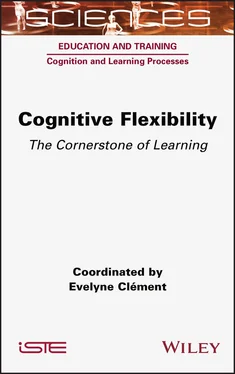Evelyne Clement - Cognitive Flexibility
Здесь есть возможность читать онлайн «Evelyne Clement - Cognitive Flexibility» — ознакомительный отрывок электронной книги совершенно бесплатно, а после прочтения отрывка купить полную версию. В некоторых случаях можно слушать аудио, скачать через торрент в формате fb2 и присутствует краткое содержание. Жанр: unrecognised, на английском языке. Описание произведения, (предисловие) а так же отзывы посетителей доступны на портале библиотеки ЛибКат.
- Название:Cognitive Flexibility
- Автор:
- Жанр:
- Год:неизвестен
- ISBN:нет данных
- Рейтинг книги:4 / 5. Голосов: 1
-
Избранное:Добавить в избранное
- Отзывы:
-
Ваша оценка:
- 80
- 1
- 2
- 3
- 4
- 5
Cognitive Flexibility: краткое содержание, описание и аннотация
Предлагаем к чтению аннотацию, описание, краткое содержание или предисловие (зависит от того, что написал сам автор книги «Cognitive Flexibility»). Если вы не нашли необходимую информацию о книге — напишите в комментариях, мы постараемся отыскать её.
Cognitive Flexibility — читать онлайн ознакомительный отрывок
Ниже представлен текст книги, разбитый по страницам. Система сохранения места последней прочитанной страницы, позволяет с удобством читать онлайн бесплатно книгу «Cognitive Flexibility», без необходимости каждый раз заново искать на чём Вы остановились. Поставьте закладку, и сможете в любой момент перейти на страницу, на которой закончили чтение.
Интервал:
Закладка:
Beyond the fact that no measure can be considered to uniquely and purely assess cognitive flexibility, each chosen measure influences the type of flexibility that is assessed. Researchers and practitioners wishing to use a measure of flexibility should therefore first establish precisely what flexibility they wish to measure, in order to choose their tool accordingly.
In the field of categorization development, for example, as Blaye and Bonthoux (2001) proposed, we consider that two levels of flexibility must be distinguished.
The first, long considered as evidence of flexibility in the use of several categorization modes, rather corresponds to the possibility of multiple pairings for the same object. In a situation of choice of association with a target image (e.g. a dog), children aged 2–3 are able to choose, in turn, a thematic associate (a doghouse) and a taxonomic associate (a frog).
But this first level does not imply a real controlled switch between two modes of categorization, used in a conscious and controlled way by the child. It implies, certainly, a possibility of pluri-representations for the same object, but a weak representation of the categorical relations in play.
In this case, choices could be guided on a case-by-case basis by the stimuli. A more controlled flexible use of categorical relations would correspond to what we call categorical flexibility and could be assessed by a task, as we have proposed (Maintenant and Blaye 2008; Maintenant et al. 2011), involving maintaining the use of one categorization mode over several trials, concerning several different targets, and then switching to the use of another categorization mode over several trials again.
This second level of flexibility would require top-down control and thus more precise representations of categorical relations. This second level would be accessible later. We have been able to show that, when it comes to switching in a controlled way from one mode of categorization to another, it is necessary to wait until 8–9 years of age (Maintenant and Blaye 2008). Moreover, this categorical flexibility would imply sufficient conceptualization of the categorical relations to be used (Maintenant and Pennequin 2016).
Indeed, whether in children or adults, whether the switch is requested on instruction (deductive categorial flexibility) or induced by feedback (inductive categorial flexibility), we have been able to demonstrate that this categorial flexibility requires a sufficient level of representation of the categorization modes and a better conceptualization than during multi-pairing (Maintenant et al . 2013; Maintenant and Pennequin 2016).
Moreover, with Blaye et al . (2007), Maintenant and Blaye (2008), Maintenant et al. (2011), we consider that categorial flexibility has two components: certainly the switching component, allowing us to be flexible in a controlled way according to the demands of the situation, but also the maintenance component, allowing us to not change our functioning or way of thinking in a controlled way, if this proves to be appropriate to the situation.
We can thus ask ourselves what it means to be flexible, to change, in a controlled way, representation, ways of thinking and strategy according to the requirements of the situation. If we subscribe to such a definition, some of the tasks mentioned above might not fall into the category of cognitive flexibility tasks as such.
All of these tasks, of the reaction time type, which only involve switching from one mode of response to another in a few fractions of a second, certainly make it possible to assess a switching cost . But they do not really allow us to assess cognitive flexibility in the sense of our ability to switch, in a controlled way, from one task to another according to the requirements of the situation, and not according to a possible learning of a correspondence between a cue and a task to be performed.
This assessment would require, on the one hand, proposing more elaborate tasks and, on the other hand, making sure that there has been a conceptualization and a maintenance of the use of the first task. Indeed, in order to consider that a person switches in a flexible, controlled way between two tasks, it is necessary to be sure that the first task has been implemented as such by the person. To take an example: if I sleep during the mathematics lesson, it will probably be easier for me to switch to the French lesson than for another student who has fully invested themselves in learning during the mathematics lesson and in doing the exercises.
As we have been able to demonstrate (Maintenant et al. 2013; Maintenant and Pennequin 2016), in the field of categorial flexibility, switching in a controlled manner from one mode of categorization to another involves not only the executive aspects inherent to this activity (flexibility, inhibition), but also the conceptualization of the modes of categorization to be used. The quality of the representation and the level of mastery of the activities, which we must switch between during a flexibility task, are therefore crucial and must be taken into account during an assessment.
As already proposed by Karmiloff-Smith (1992, 1994), cognitive flexibility implies a possibility of representational redescription. Whether it is in the context of an assessment by a task switching situation or in the context of an assessment by categorial flexibility or problem-solving tasks (Clément 2006; Clément and Gavornikova-Baligand 2010), it seems to emerge from these measures of cognitive flexibility that it is necessary to represent the same object or the same situation in different ways. Cognitive flexibility thus seems to imply “re” representing a stimulus, with different levels of possible conceptual representations, from the lowest level, such as learned associations between cues and specific responses (task switching) to higher levels, such as problem-solving situations involving a modification of the conceptualization of a situation.
1.4. Conclusion
Cognitive flexibility is very present in our daily lives, throughout our lives and is lacking in many pathologies, so its measurement appears to be necessary and informative for psychologists and psychological researchers.
The set of measures presented here clearly shows the great diversity that exists concerning these tools for measuring cognitive flexibility. In addition to the reminder of the type of flexibility measured, which may depend largely on the type of tool chosen, we encourage practitioners and researchers to cross-reference information sources and to make this great diversity a strength, allowing for a better approach to the real competence of the person being assessed.
1.5. References
Baldy, R. (2010). Dessine-moi un bonhomme. Dessins d’enfants et développement cognitif . Éditions In Press, Paris.
Benson, J. and Sabbagh, M.A. (2013). Le lien entre les fonctions exécutives et la cognition sociale. In Encyclopédie sur le développement des jeunes enfants [Online]. Available at: http://www.enfant-encyclopedie.com/fonctions-executives/selon-experts/le-lien-entre-les-fonctions-executives-et-la-cognition-sociale.
Blaye, A. and Bonthoux, F. (2001). Thematic and taxonomic relations in preschoolers: The development of flexibility in categorization choices. British Journal of Developmental Psychology , 19, 395–412.
Blaye, A., Bernard-Peyron, V., Paour, J.L., Bonthoux, F. (2006). Categorical flexibility in children: Distinguishing response flexibility from conceptual flexibility; the protracted development of taxonomic representations. European Journal of Developmental Psychology , 3(2), 163–188.
Blaye, A., Chevalier, N., Paour, J.L. (2007). A dog as an animal or a dog as a rescuer; the development of categorical flexibility. Cognition, Brain, and Behavior , 11(4), 791–808.
Читать дальшеИнтервал:
Закладка:
Похожие книги на «Cognitive Flexibility»
Представляем Вашему вниманию похожие книги на «Cognitive Flexibility» списком для выбора. Мы отобрали схожую по названию и смыслу литературу в надежде предоставить читателям больше вариантов отыскать новые, интересные, ещё непрочитанные произведения.
Обсуждение, отзывы о книге «Cognitive Flexibility» и просто собственные мнения читателей. Оставьте ваши комментарии, напишите, что Вы думаете о произведении, его смысле или главных героях. Укажите что конкретно понравилось, а что нет, и почему Вы так считаете.












